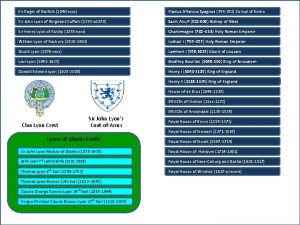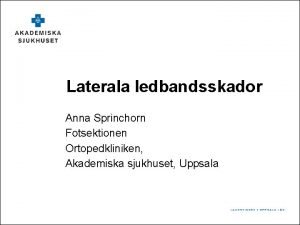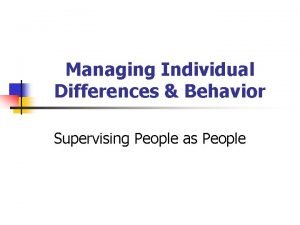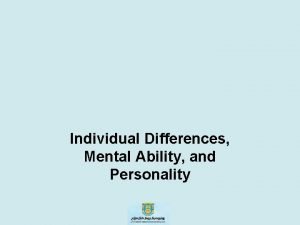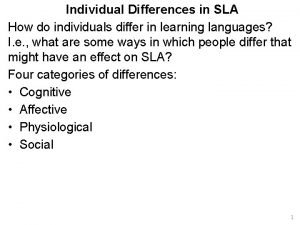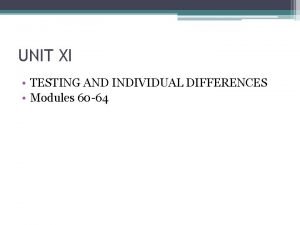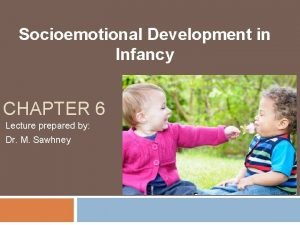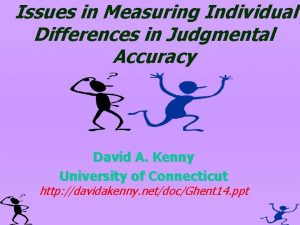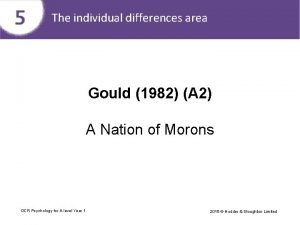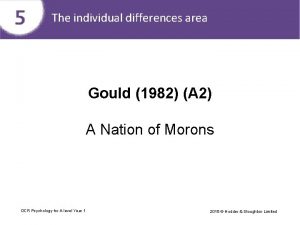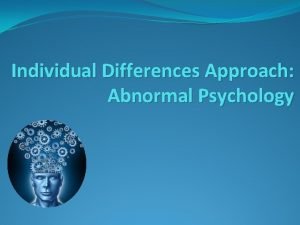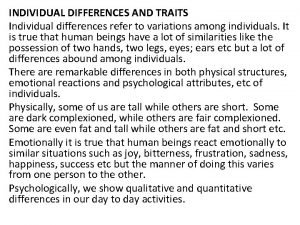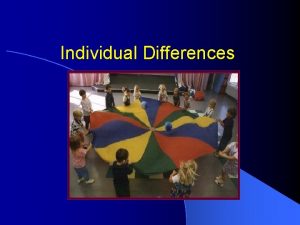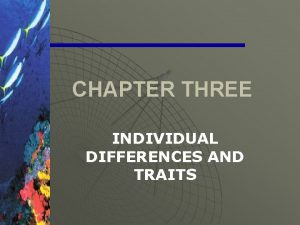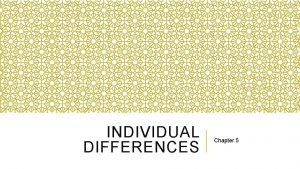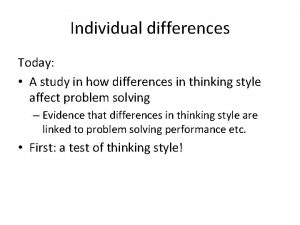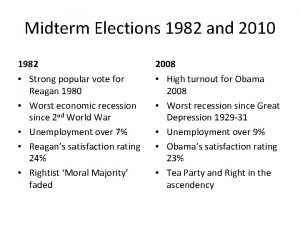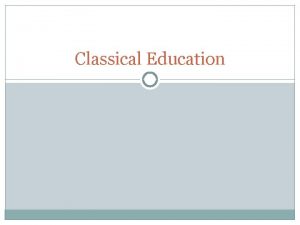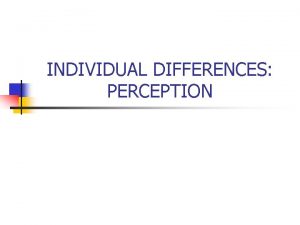The Individual Differences Area Classical study Gould 1982
































- Slides: 32

The Individual Differences Area Classical study: Gould (1982) Bias in IQ testing Contemporary study: Hancock et al. (2011) The language of psychopaths

The individual differences area How does the individual differences area explain behaviour? With consideration to the bullet points below, answer the following question: Define the individual differences area (4 marks) The other four areas we have studied have been concerned with the similarities between people, what people have in common. This area studies people too, but rather looks at what? Does the area focus on environmental factors or individual factors? Does it assume that individuals are unique or all the same? This area looks at normality and abnormality, as well as personality and intelligence. Are these concepts easy to measure or difficult? How might they be studied?

The individual differences area How does the individual differences area explain behaviour? With consideration to the bullet points below, answer the following question: Define the individual differences area (4 marks) The other four areas we have studied have been concerned with the similarities between people, what people have in common. This area studies people too, but rather looks at what? • The area looks at the differences between people Does the area focus on environmental factors or individual factors? • The area believes individual factors will explain behaviour Does it assume that individuals are unique or all the same? • All individuals are unique This area looks at normality and abnormality, as well as personality and intelligence. Are these concepts easy to measure or difficult? How might they be studied? • These concepts are difficult to measure and quantify. They may be measured through selfreport and case studies. These often may not be representative or generalisable.

Strengths of the individual differences area Research within this area investigates phobias, what is the benefit of this? Research within this area investigates intelligence, what is the benefit of this? The area is concerned with why people have things and why people do not. Give an example of something that someone may have and other people may not.

Strengths of the individual differences area Research within this area investigates phobias, what is the benefit of this? • It gives an insight into where phobias come from, how to treat phobias and how to overcome phobias. This could be useful to anyone worldwide. Research within this area investigates intelligence, what is the benefit of this? • It informs us about intelligence, what it is, how it can be improved. This could be very useful to educators worldwide. The area is concerned with why people have things and why people do not. Give an example of something that someone may have and other people may not. • Disorders for example.

Weaknesses of the individual differences area As the area involves research based on case studies, what does this mean in terms of: a) Validity b) Reliability c) Generalisability Research which measures why people are different may emphasise the differences between groups in society. What may this lead to?

Weaknesses of the individual differences area As the area involves research based on case studies, what does this mean in terms of: a) Validity – Limited validity as often self-reports are used (often no scientific basis). For example, Freud b) Reliability – Procedure may not be controlled and standardised as it is only one individual. Especially if self-report is used. Therefore, not reliable c) Generalisability – Could only be applicable to one person only. For example, Little Hans Research which measures why people are different may emphasise the differences between groups in society. What may this lead to? It may lead to more segregation between groups, encourage stigma and cause harm.

Core studies There are four core studies which fall under the individual differences area. We have already looked at two so far. List them below. 1. 2. We will now be looking at two new studies this week: 1. Gould (1982) Bias in IQ testing 2. Hancock et al. (2011) The language of psychopaths

Classical study: Gould (1982) Bias in IQ testing Area: Individual differences area Theme: Measuring differences

What is the purpose of an IQ test? • To measure one’s intelligence • It is assumed ones IQ score represents their intelligence I want you to think and consider the following: • What is intelligence? • How can you measure intelligence? For example, does your Psychology A -level exam really measure your intelligence in Psychology • Are you born intelligent? • Is there a ‘fixed’ point of intelligence within you?

Intelligence • A psychological construct • Implied meaning of the ability to acquire information, to think and to reason • No universal definition • More contemporary definitions stress adaptation to the environment vs IQ • A statistical concept • Measurement of a persons ability to undertake language, numerical and reasoning through a test • Measured on a nominal scale – tells us whether one person is more intelligent than another • Is said to correlate with academic achievement

Background: • In 1905, the Simon-Binet test, the world’s first intelligence test was developed • 5 years later this was adapted for use in the USA and it became known as the Stanford-Binet test • In 1944 the most widely used test of adult intelligence, the Wechsler Adult Intelligence Scale (WAIS) was born. Intelligence is not fixed at birth nor is it down to genetics. It can be influenced by the environment

Background: “A Nation of Morons” Gould did not conduct an experiment or a study. He reviewed an already existing publication by Yerkes. Gould, along with many others, were very critical of the Yerke’s research and the impact that it had on many people’s lives. This key study is about Gould and his review article of Yerkes’ original study.

Gould’s aim: To examine… • Issues with psychometric testing, specifically IQ tests • Ways in which IQ test support racist views on inherited intelligence

Yerkes research Similar to ‘quasi’ experiment • When America became involved in WW 1, over a million recruits were required • Yerkes combined his early ideas of inherited intelligence and the development of mental testing and developed the Army Alpha and Beta tests as a way of selecting recruits Note: this was not an experiment or piece of empirical research. It is an abstract from Gould’s (1981) book where he discusses measuring of human intelligence

Test 1: Army Alpha • Written test for literate men • Included questions about number sequences, analogies and other familiar IQ questions • Yerkes believed the test measured native intellectual ability, which is not influenced by education or culture • However, it is criticised for being very culturally bias – someone unfamiliar with American culture would perform poorly on this

Test 2: Army Beta • Designed for illiterate individuals or those who failed the Alpha test • Pictures used were culturally specific and if participants had no knowledge of the items, they would have been unable to the answer questions correctly • Instructions were written in English and three parts of the test required written answers – hardly suitable for illiterate people! Test 3: The Interview • Those who failed this test were given an individual verbal exam

Method mentioned by Yerkes: SAMPLE • 1. 75 million US army recruits from different backgrounds during WW 1 • The recruits included White Americans, ‘Negroes’ and European immigrants • Do not refer to the Army recruits as ‘participants’

Issues identified by Yerkes • Yerkes found that many recruits had spent little time in education and so the queue for the Beta test grew. • The standards required to take the Alpha were lowered, but not consistently across all army camps. In some, schooling up to the third grade counted as literate (so they would have to take the Alpha) and in others anyone who could read took the Alpha. • Those individuals who failed the Alpha should have filtered through the system and taken the Beta, but due to time constraints they didn’t and as a result many scored zero.

Qualitative results ‘It was touching to see the intense effort … put into answering the questions, often by men who never before had held a pencil in their hands. ’ Examiner for the Beta test, 1968, recalling his experience The Beta test was designed to be used by illiterate men, but it still relied on pencil work (writing), knowledge of numbers and how to write them.

Results from Yerkes: Data was analysed (by E. G. Boring) looking for racial and national averages • Explain what is good about the data being analysed by someone who is not Yerkes? • Explain what is bad about the focus of Boring? Data analysis found: • Average white American male = mental age 13 • Average Black male = 10. 4 (“the lighter the skin colour; the higher the score”)

Yerkes: Why were there differences? • Eugenicists (people who study in the possibility of improving the qualities of human species) suggested white American males scored so poorly because… “‘the poor, Negroes and feeble-minded’ had interbred and lowered the overall intelligence of the population. ”

These tests had large implications Bearing in mind that these tests were now accepted measures of innate intelligence, here was evidence that there really was a difference between racial and national groups in their levels of intelligence In 1924 the Immigration Restriction Act was passed, • Europeans who had scored very poorly on the tests were consequently no longer welcome in the country • It was then decided a quota of imigrants were to be allowed into America (2%), ensuring the ‘unwanted’ were low in the US • One of the groups that was found to be low in intelligence were the Jews. Many fled their country of origin and were denied entry to the US. The fate of many of these are known from the Nazi regime

• ‘I believe those tests were worth what the war cost, even in human life, if they served to show clearly to our country, and the degrees of intelligence in different races who are coming to us, in a way which no one can say is the result of prejudice … We have learned once and for all that the Negro is not like us. So in regard to many races and sub -races in Europe we learned that some which we had believed possessed of an order of intelligence perhaps superior to ours [i. e. Jews] were far inferior. ’ • Henry Fairfield Osborn (president of the American Museum of Natural History), 1923 • ‘We know what happened to many who wished to leave but had nowhere to go. The paths to destruction are often indirect, but ideas can be agents as sure as guns and bombs. ’ • Gould, 1982

Gould: Why were there differences? • Men were often allocated an inappropriate test – flawed results • Culturally bias = test was designed by white, middle class American males. Therefore, suited to a particular group • Language barrier – recent immigrants highly disadvantages • Positive correlation between stay in US and score – what does this mean?

Gould: A number of conclusions • IQ tests are both culturally and historically biased • IQ tests do not measure innate intelligence • IQ tests do not provide valid results, offering unreliable results. • Inappropriate and poorly administered IQ tests have led to tragic consequences.

The Beta test still relied on certain skills, like number, etc. The data was analysed subjectively. One of Yerkes’ followers carried out the analysis and the conclusions were made to fit the hereditary argument. Criticisms of the tests Many of the questions were culturally biased. Many individuals took the Alpha when they should have been taking the Beta. They then should have been picked up due to their low score and completed the Beta, but many weren’t. Black recruits and recent immigrants were the ones most likely to be taking the wrong test. This is because they often couldn’t read/use a pencil but due to demand they had to take whatever test was available.

How does Gould’s study link to the area it falls under? • Gould’s study falls within the individual differences area because it is reviewing an attempt (by Yerkes) to develop a way of measuring how individuals differ in their intelligence.

How does Gould’s study link to theme of the area? • The key theme of this study is ‘measuring differences’; Yerkes attempted to measure the intellectual differences of First World War recruits. • Gould argues that psychologists should be careful when measuring differences as cultural biases may impact the findings. There is also the possibility of the results not being socially sensitive and being misused.

Evaluation Validity • What issues were there with the tests themselves? • What issues were there with the allocation of the tests? Reliability • Was the allocation of the test consistent throughout? Representative • Who are the tests representative of? • Can the results of Yerkes study be representative?

Evaluation Ethnocentrism • Consider who the tests were made by and made for • Consider what the correlation between stay in US and test score means • The sample were only split into three groups – White Americans, ‘Negroes’ and European immigrants – is this accurate? What does it mean in terms of generalising? Socially sensitive research • Discuss the implications of Yerkes study upon society. • Do you think the study could be responsible for stigma which exists today? • Gould aimed to point out the errors of Yerkes study, do you think this resolved the negativity which followed his study?

Exam questions • In your workbooks, there are 1 -9 exam questions for you to work through. • Remember, for questions 8 and 9 follow the structure: • State theme/clearly explain area (1 mark) • Briefly explain what study looked at – specify variables (1 marks) • Clearly explain how both link together – what are they both interested in? (1 mark)
 Robert gould augsburg
Robert gould augsburg How did jay gould treat his workers
How did jay gould treat his workers Gospel of wealth apush definition
Gospel of wealth apush definition Goggletranslate
Goggletranslate Jay gould achievements
Jay gould achievements Which is larger
Which is larger Abigail gould
Abigail gould Draglådetest
Draglådetest Flu
Flu Operant vs. classical conditioning
Operant vs. classical conditioning Classical conditioning v. operant conditioning
Classical conditioning v. operant conditioning Classical conditioning model of learning
Classical conditioning model of learning Managing individual differences and behavior
Managing individual differences and behavior Proactive personality
Proactive personality Field dependent vs field independent
Field dependent vs field independent Individual differences factors
Individual differences factors Perbedaan individu dalam organisasi
Perbedaan individu dalam organisasi Apa makna perbedaan individu dalam dunia kerja
Apa makna perbedaan individu dalam dunia kerja What are type a people
What are type a people Individual differences in sla
Individual differences in sla Unit xi testing and individual differences
Unit xi testing and individual differences The basic principles of training
The basic principles of training Principles of training individual differences
Principles of training individual differences Involves individual differences in behavioral styles
Involves individual differences in behavioral styles Conclusion of individual differences
Conclusion of individual differences Difference between growth and development
Difference between growth and development Tim crawford cpa
Tim crawford cpa Odisha apartment ownership act 1982
Odisha apartment ownership act 1982 1982 loi de décentralisation
1982 loi de décentralisation Une 1032
Une 1032 Batas pambansa blg 232 education act of 1982 tagalog
Batas pambansa blg 232 education act of 1982 tagalog Toi and batson 1982
Toi and batson 1982 1982-1938
1982-1938






